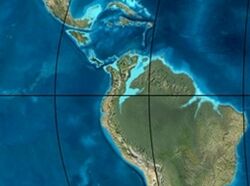Earth:Usme Formation
| Usme Formation Stratigraphic range: Late Eocene-Early Oligocene ~40–30 Ma | |
|---|---|
| Type | Geological formation |
| Underlies | Tilatá Formation |
| Overlies | Regadera Formation |
| Thickness | up to 300 m (980 ft) |
| Lithology | |
| Primary | Shale, sandstone, conglomerate |
| Location | |
| Coordinates | [ ⚑ ] : 4°21′40.3″N 74°07′50″W / 4.361194°N 74.13056°W |
| Region | Bogotá savanna, Altiplano Cundiboyacense Eastern Ranges, Andes |
| Country | |
| Type section | |
| Named for | Usme |
| Named by | Hubach |
| Location | Usme, Bogotá |
| Year defined | 1957 |
| Coordinates | [ ⚑ ] 4°21′40.3″N 74°07′50″W / 4.361194°N 74.13056°W |
| Region | Cundinamarca |
| Country | |
 Paleogeography of Northern South America 35 Ma, by Ron Blakey | |
The Usme Formation (Spanish: Formación Usme, Tsu, Teu) is a geological formation of the Bogotá savanna, Altiplano Cundiboyacense, Eastern Ranges of the Colombian Andes. The formation consists of a lower part with predominantly shales with intercalated sandstone beds and an upper sequence with sandstones and conglomerates. The Usme Formation dates to the Neogene and Paleogene periods; Late Eocene to Early Oligocene epochs, and has a maximum thickness of 300 metres (980 ft).
Etymology
The formation was defined by Hubach in 1957 and named after the locality of Usme, Bogotá.[1]
Description
Lithologies
The Usme Formation is subdivided into a lower sequence of shales with intercalated sandstones and an upper part of sandstones and conglomerates.[1]
Stratigraphy and depositional environment
The Usme Formation unconformably overlies the Regadera Formation and is overlain by the Tilatá Formation.[2] The age has been estimated, based on palynological data, to be Late Eocene to Early Oligocene.[1] The depositional environment has been interpreted as marine with the upper part deposited in a deltaic setting.[3]
Outcrops
Lua error in Module:Location_map at line 522: Unable to find the specified location map definition: "Module:Location map/data/Bogotá savanna" does not exist. The Usme Formation is found in its type locality in the synclinal of Usme, the valley of the Tunjuelo River.[1]
Regional correlations
See also
 Geology of the Eastern Hills
Geology of the Eastern Hills Geology of the Ocetá Páramo
Geology of the Ocetá Páramo Geology of the Altiplano Cundiboyacense
Geology of the Altiplano Cundiboyacense
Notes and references
Notes
References
Bibliography
- Bayona, Germán; Omar Montenegro; Agustín Cardona; Carlos Jaramillo; Felipe Lamus; Sara Morón; Luiz Quiroz; María C. Ruíz, and Victor Valencia and Mauricio Parra. 2010. Estratigrafía, procedencia, subsidencia y exhumación de las unidades paleógenas en el Sinclinal de Usme, sur de la zona axial de la Cordillera Oriental - Stratigraphy, provenance, subsidence and exhumation of the Paleogene succession in the Usme Syncline, southern axial zone of the Eastern Cordillera. Geología Colombiana 35. 5-35. Accessed 2017-03-16.
- Guerrero Uscátegui, Alberto Lobo. 1992. Geología e Hidrogeología de Santafé de Bogotá y su Sabana, 1–20. Sociedad Colombiana de Ingenieros.
- Montoya Arenas, Diana María, and Germán Alfonso Reyes Torres. 2005. Geología de la Sabana de Bogotá, 1–104. INGEOMINAS.
Maps
- Acosta, Jorge E., and Carlos E. Ulloa. 1998. Plancha 246 - Fusagasugá - 1:100,000, 1. INGEOMINAS. Accessed 2017-06-06.
External links
- Gómez, J.; N.E. Montes; Á. Nivia, and H. Diederix. 2015. Plancha 5-09 del Atlas Geológico de Colombia 2015 – escala 1:500,000, 1. Servicio Geológico Colombiano. Accessed 2017-03-16.
 |
